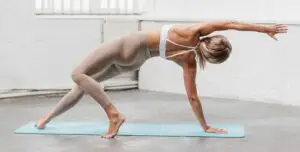If you’ve practiced Yoga Nidra before, you would most likely describe it as a guided meditation. Perhaps your teacher even called it that. However, did you know that there are many differences between Yoga Nidra and meditation?
Yoga Nidra is not a meditation but a practice in its own right. Meditation is a broad term with various styles and ways to meditate. But Yoga Nidra is a structured practice that you do in a specific way. So rather than meditation, you can call it guided relaxation or deep rest practice.
Confused? Don’t worry! In this article, I’ll break down the differences and explain how Nidra and meditation are two distinct practices.
What is the difference between Yoga Nidra and Meditation?
Yoga Nidra offers many of the same benefits as meditation; it calms your mind, increases your focus, and promotes spiritual growth. But there are differences between how you perform Nidra and meditation and how it makes you feel.
Yoga Nidra follows eight specific stages
If you have some experience with meditation, you’ll know the practice is very fluid. My meditation teachers frequently told me that there is no one way to meditate and that meditation practice is personal. So, what meditation is for me could be very different from what it is for you.
In meditation, you typically maintain your focus on something; usually, it’s your breath, a body part, or a mantra. In Yoga Nidra, these elements are there, but the practice is much more than maintaining your focus on one thing.
Yoga Nidra is a structured practice with eight phases, four of which must be in every session. You must also follow the stages in a specific order to reach the deepest state of relaxation. So while you will focus on your breath at one point, there are various other elements to it.
You cannot do Yoga Nidra seated
The traditional meditation position is seated. While studying Buddhist meditation in Thailand, the monks told me that you must remain seated to avoid falling asleep. They explained that as your body and mind relax, you may get the urge to lay down and sleep. However, to maintain your focus on the breath, you should try to resist this desire.
In this sense, Yoga Nidra is the opposite. You perform Nidra laying down on your back, and falling asleep during Yoga Nidra is much more acceptable. Sitting cross-legged for more than 10 minutes becomes comfortable and even painful for many people. But in Yoga Nidra, it’s essential to release all tension to enter deeper states of consciousness, so a reclined position is encouraged.
You need at least 15 minutes for Yoga Nidra
You can meditate for as little or as long as you like. So, if you only have five minutes, it’s still possible to meditate for that short period. Additionally, many experienced practitioners may have meditation sessions that last for several hours.
However, as Yoga Nidra has multiple stages, a Nidra practice requires at least 15-minutes. You can spend more time on each phase to extend the duration, but a Yoga Nidra session typically does not last longer than one hour.
You cannot do Yoga Nidra with your eyes open
Lastly, certain styles of meditation require you to keep your eyes open. Two examples are walking meditation and gazing meditation (Trataka). In gazing meditation, you maintain a relaxed gaze on an external object such as a candle. On the other hand, in Yoga Nidra, you must close your eyes to withdraw the sense of sight and focus on the instructions given.
Why do people call Yoga Nidra a guided meditation?
You’ve probably seen or heard various people refer to Yoga Nidra as a form of guided meditation. So naturally, you may be confused to hear that it is not the same thing. People refer to Nidra as a guided meditation to help new practitioners differentiate Yoga Nidra from the many Yoga asana styles.
For example, if you’ve never heard of Yoga Nidra and see a class advertised at your local yoga studio, you would likely assume it’s an asana class. But Yoga Nidra is much closer to meditation than asana, so in marketing, it makes sense to call it a guided meditation.
Some teachers also call Yoga Nidra a meditation because they combine the two practices. You can take one or more of the eight Nidra stages and use them in meditation. Doing this is fine, but you cannot call it an authentic Yoga Nidra practice.
For example, many yoga teachers incorporate the body scan phase into savasana, teaching the final resting pose as a guided meditation. Additionally, the breath awareness stage, where you count your breath, is used similarly in meditation.
Yoga Nidra is not a meditation, but you can incorporate one or more Nidra stages into a meditation, making it a “Nidra style guided meditation.” Just bear in mind that if you blend Yoga Nidra with meditation in this way, the effects of the session will not be the same as doing a full Yoga Nidra practice.
Can I do Yoga Nidra after Meditation?
So now you know that they are two different practices, you might wonder if you can do Yoga Nidra after meditating. Some people like to practice Yoga Nidra after meditation when they feel more relaxed. Thus, they can reach deeper states of consciousness in the Nidra session. For this reason, you can also practice Yoga Nidra after a yoga asana practice or after pranayama.
You can also do meditation after Yoga Nidra. If your mind is hectic, you might find it easier to maintain your focus during meditation after a relaxing practice like Yoga Nidra. Because the best time to practice Yoga Nidra is in the evening, combining these two calming practices is a great way to wind down before bed. But maybe avoid practicing both Nidra and meditation in the morning as it might make you a bit too yin!
Final Thoughts
While Yoga Nidra is not the same as meditation, it uses powerful meditative techniques and shares many of the same benefits. In addition, the practices complement each other so well that they can be and are often blended. However, to maximize the unique benefits of Yoga Nidra, I recommend practicing it in its traditional form.








